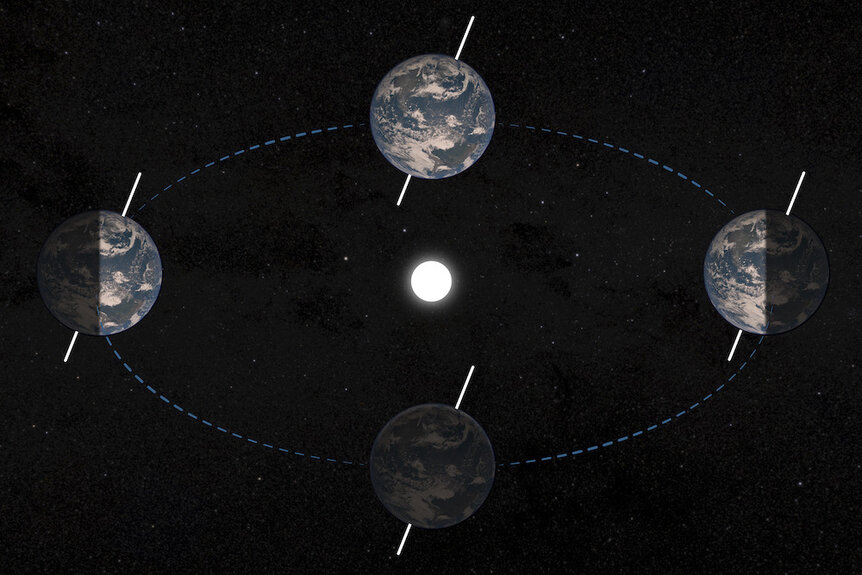Create a free profile to get unlimited access to exclusive videos, sweepstakes, and more!
Axial Tilt: The Reason for Earth's Seasons
If you want seasons, you need a planet that's a little sideways.

For many kids, the combination of good weather and lack of school obligations makes summertime synonymous with good times. Three solid months of freedom, soaked in the Sun, without adults looking over your shoulder all the time. It’s the sort of setting that can build lifelong memories and life-altering mistakes.
Travel back in your mind to the summer of 1996. Four teenagers, each of them unrealistically attractive as portrayed by Jennifer Love Hewitt, Sarah Michelle Gellar, Ryan Phillippe, and Freddie Prinze Jr., are driving along the beach when they hit a pedestrian. Under the combined influence of youth and fear, they decide to discard the body in the water, even after realizing their victim isn’t yet dead. That decision comes back to haunt them a year later in I Know What You Did Last Summer, streaming now on Peacock.
RELATED: In Praise of The I Know What You Did Last Summer Sequel Names
The story relies on a corruption of summer’s innocence by bringing death (typically associated with winter) to the usually vibrant mid-year months. More than that, it relies on the concept of seasons, something we take for granted but which only exists due to the ways our planet moves through space.
Summer, Winter, or Fall, Seasons All Come Down to Axial Tilt
Depending on where you live, you become accustomed from a young age to a certain cycle of seasons. Generally speaking, you have a few months of intense heat, a few months of intense cold, and a couple of mild transitionary periods between. We take for granted that this cycle is normal, but don’t often think about why it happens.
A common first guess is that the Earth is farther from the Sun during the winter and closer during the summer, but that isn’t it. In fact, summer in the Northern Hemisphere happens while the Earth is farthest from the Sun and winter happens when it’s closest. Distance from the Sun absolutely impacts how much solar radiation a planet gets and what sorts of temperatures it can reach, but the fluctuations in Earth’s orbit don’t make much of a noticeable difference. Instead, the secret to the seasons is axial tilt.
Most things in the solar system orbit more or less along the ecliptic plane (an imaginary line containing Earth’s orbit around the Sun and stretching out into space). That’s because the solar system is spinning. Just like a pizza dough tossed overhead, the system’s rotational energy stretches it out in a relatively flat plane. You might expect then that the Earth would rotate along the same ecliptic plane, but it doesn’t.
Astronomers have suggested that the Earth may once have spun straight up and down along the ecliptic with no tilt at all, like a whizzing top. Then, about 100 million years into the development of the solar system, a protoplanet called Theia snuck in and smashed into the fledgling Earth. The collision kicked up a lot of debris which eventually coalesced into the Moon, and it also knocked the Earth about 23 degrees off true.
RELATED: What is the Summer Soltice, Astronomically Speaking?
That tilt remains fixed in place even as the world orbits around the Sun, always pointing in the same direction. That means that each pole is tilted toward the Sun for half of the year and away from the Sun for the other half, that’s what causes the seasons.
Seeing Earth’s Tilt in the Equinoxes
You can actually see the effects of the Earth’s tilt in the sky. It’s the reason the Sun doesn’t rise due east or set due west, except for twice a year on the equinoxes. During an equinox, the Sun is shining directly toward the equator and both hemispheres get equal amounts of daylight. On September 23, the Earth passed through the part of its orbit known as the autumnal equinox. Ever since then, the northern hemisphere has turned increasingly toward deep space with each passing day. The amount of sunlight hitting the Northern Hemisphere is decreasing, the days are getting shorter, and the average temperature colder.
That will continue until the winter solstice on December 21. At that point, the Northern Hemisphere will experience its longest night and shortest day. Then the days will start getting longer again until the vernal equinox on March 20, when the amount of daylight will once again be equal on both hemispheres. The days will continue growing longer in the Northern Hemisphere, the temperatures warmer, and summer will return. That’s true, at least, for people in most parts of the world. But the Earth’s tilt causes something pretty weird to happen at the poles.
The Extreme Seasons of the Poles
It’s common knowledge that the seasons are more dramatic the farther you travel from the equator. That’s because the Earth’s tilt, combined with the curvature of the Earth, results in dramatically less daylight the closer you get to the winter pole.
Once you reach northern latitudes, you find increasingly long nights and brief days as you approach the Arctic Circle. Beyond that imaginary line, 23 degrees south of the pole, the Sun never rises during the winter. The Earth is so tilted that anything north of that line never rotates into its warm embrace. The North Pole doesn’t see the Sun again until the planet makes it back around to the other side.
RELATED: Humans Moved So Much Water Around, We Changed the Earth’s Tilt
Meanwhile, the opposite is happening at the South Pole. While the north is plunged in perpetual night, the south is bathed in the warmth (fleeting as it may be at those latitudes) of a Sun that never sets. The extremes at the poles highlight the truth of what’s happening; there are really only two seasons with some nebulous transitionary periods between.
Something like 4.4 billion years ago, a still-forming planet smashed into the Earth, and we still feel the ache of that injury every winter. Whether you’re a teenager or a planet, you can’t get away with a hit and run. From vengeful slashers to axial tilt, you always leave evidence behind.
Catch I Know What You Did Last Summer, streaming now on Peacock.





























